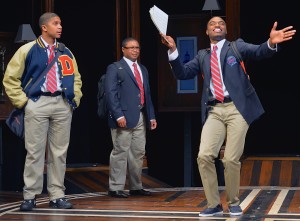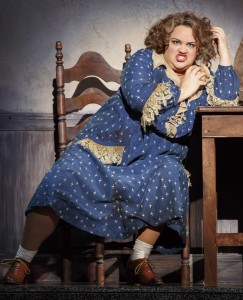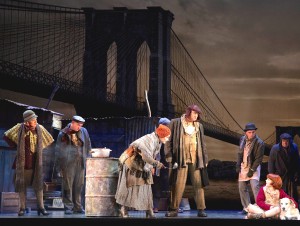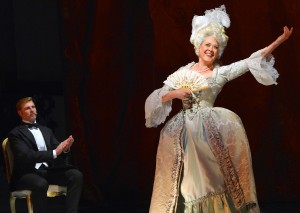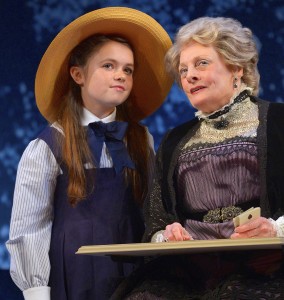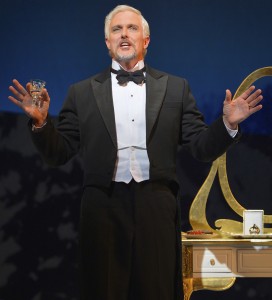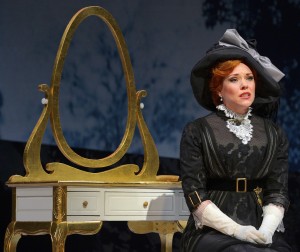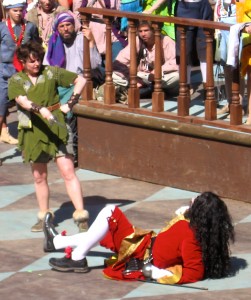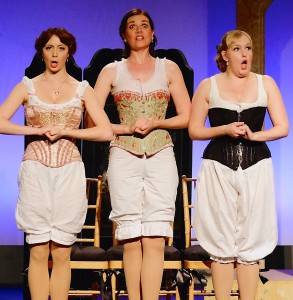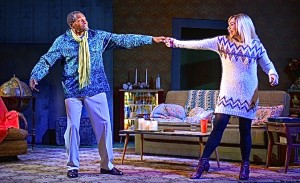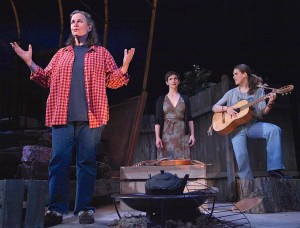
Pharus (Jelani Alladin, left) and his teacher, Mr. Pendleton (Charles Shaw Robinson), share a connective moment in “Choir Boy.” Photo by Kevin Berne.
[Woody’s [rating: 5]
I can’t remember ever feeling as white as when I saw “Choir Boy,” the new Marin Theatre Company drama.
The play, which provides scaffolding for the notion of tolerance, is incredibly powerful.
And incredibly black.
Playwright Tarell Alvin McCraney immediately sets the tone with a black prep school commencement where the words “sissy” and “nigger” are hurled at a gay student.
I thought I’d been color-blind all my life.
I’d banded on civil rights issues in the early ‘60s with militant black attorney Paul Zuber and self-styled radical lawyer Paul Kunstler.
Earlier, I’d joined my father in welcoming into our home in a New York suburb what then were called Negroes. I’d enjoyed rhythmic, bluesy “race records” spun by “Moondog” (deejay Alan Freed) and spirituals by Mahalia Jackson and less famous African American artists. I’d been moved beyond belief by Billie Holiday wailing “Strange Fruit,” a musical lamentation for a lynching.
I thought I’d earned my liberal stripes.
In 100 “in-your-face” minutes, “Choir Boy” showed me I’ve been practically delusional.
Being Caucasian inevitably precludes a total understanding of the black condition.
“Choir Boy” is markedly pertinent today, when city after city in the United States face sharper racial divides than in decades.
During rehearsal of the show, director Kent Gash told his actors: “No play happens in a vacuum…As we have seen in recent events in Baltimore, African American male lives are at risk. It’s hard not to feel like an endangered species sometimes.”
But “Choir Boy” is more than more an eye-opener — it’s a masterpiece.
I’ve seen four previous plays by MacArthur “genius” grant winner McCraney — April’s “Head of Passes” at the Berkeley Rep, and each part of his “Brother/Sisters Plays” trilogy at the MTC, A.C.T. and Magic Theatre.
Each was extraordinary. Each was formidable.
This drama is better still.
Craney seems to be growing exponentially as a playwright as he matures (he’s only 34 now).
“Choir Boy,” a coming-of-age story but so much more, pits a gifted homosexual scholarship recipient, Pharus, against Bobby, a student with current and historic family ties to the Charles R. Drew Prep School for Boys.
That fictional school is based on real black history.
Before desegregation, about 100 such schools existed in the United States (only four remain today), which I hadn’t known.
Jelani Alladin instills vitality and reality in Pharus, a young man caught between a desire to be accepted and one of being himself, a theme that’s also reflected in other characters, particularly David, a conflicted, wannabe pastor played by Forest Van Dyke.
Pharus contrasts sharply with Bobby, hot-headedly portrayed by Dimitri Woods as a privileged rebel.
The play, which premiered in London in 2012, is not without periodic injections of humor. But it’s the anguish and poignancy that are unforgettable.
And mind-blowing.
Each of the seven “Choir Boy” cast members is superb, with each of the six black performers layering individualized vocal chops onto their thespian skills.
Ken Robinson, who plays Headmaster Marrow, a rule-oriented man steeped in tradition, has the richest, deepest voice.
None of the others are vocal slouches, though.
Spirituals — both familiar (such as “Sometimes I Feel Like a Motherless Child” and “Wade in the Water”) and not — are sprinkled throughout.
They definitely buoy the drama.
Were the originals uplifting and freeing, or did various slave songs include “coded messages”? A cerebral onstage debate may feel like a distraction from the plot yet is a meaningful connection to black history.
So’s the performance of the sole white in the all-male cast, Charles Shaw Robinson, who’s believable as Mr. Pendleton, a compassionate teacher who’d marched with Martin Luther King Jr. and participated in countless sit-ins.
You probably know somebody just like him.
Rotimi Agbabiaka, as Junior Davis, Bobby’s enabler and sidekick in delinquency, is responsible for most of the humor (though the Pharus character has his share).
And filling out the cast is Jaysen Wright as Anthony (“AJ”), a sensitive athlete-scholar.
The play, it should be noted, includes full-frontal nudity.
Alladin — in a post-play “talk-back” response to a question — explained it well: “The nudity is more than about being naked. It’s a moment when the audience is being asked, ‘Are you comfortable in your skin?’”
Most significantly, the play shows that African American men, like all others, are not one-dimensional, not stereotypes, but complex human beings.
It’s a lesson I’m unlikely to forget.
“Choir Boy” plays at the Marin Theatre Company, 397 Miller Ave., Mill Valley, through June 28. Night performances, 7 p.m. Sundays; 7:30 p.m. Wednesdays; 8 p.m. Tuesdays, Thursdays, Fridays and Saturdays. Matinees, 1 p.m. Thursdays; 2 p.m., Saturdays and Sundays. Tickets: $10 to $55. Information: (415) 388-5208 or marintheatre.org.
Contact Woody Weingarten at www.vitalitypress.com/ or voodee@sbcglobal.net



